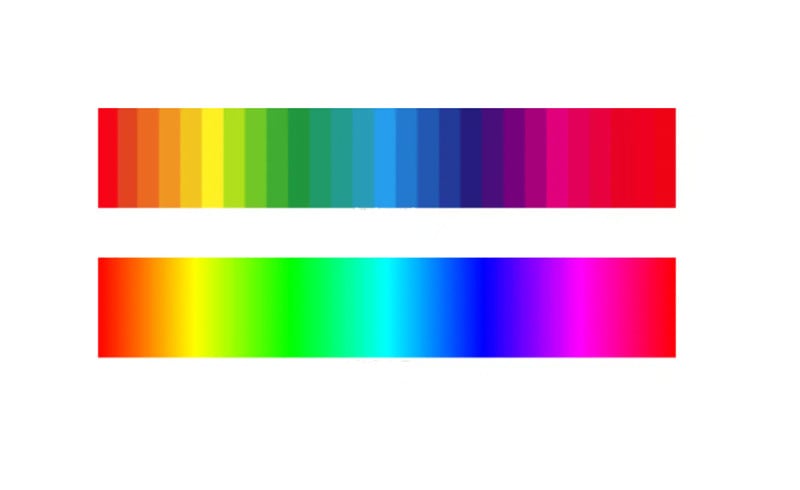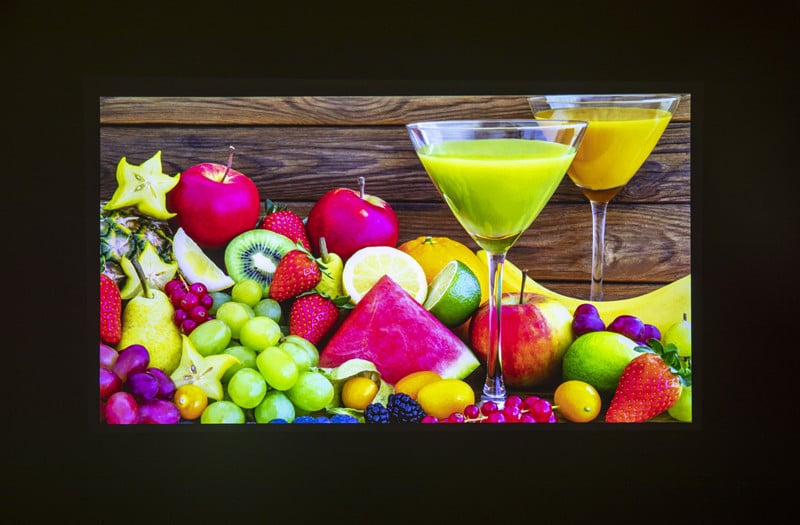



If you browse projectors on the internet, you may notice 8-bit or 10-bit in the parameter box. 8-bit and 10-bit are both measurements of color depth. In this guide, we will share what is color depth and the differences between 8-bit and 10-bit.
In this section, the definition of color depth, the calculation of color depth, true color, high color, and the difference between 8-bit and 10-bit.
Color depth is also called bit depth, which describes the color richness of color. Color depth is the number of bits used to indicate the color of a single pixel or the number of bits used for each color component of a single pixel.
The higher the color depth, the greater the number of colors, and therefore the color transition is more natural and smoother, and the striped lines are fewer. If the color depth is high enough, the transition between colors can be hard to notice.
In other words, the higher the color depth value, the more colors can be seen in the image, and the closer it can be to the true color of the image. If the color depth is too low, the image may be blurry.
In the RGB color space, the color of each pixel is composed of three colors, including Red (R), Green (G), and Blue (B). 1 bit has two colors, that is to say, each color of Red (R), Green (G), and Blue (B) can be divided into two colors. 2-bit means that each color of Red (R), Green (G), and Blue (B) can be divided into 4 colors.
You can calcite the colors of different color depth units according to the table below.
| Color depth | Available colors |
| 1-bit | 21 = 2 |
| 2-bit | 22 = 4 |
| 3-bit | 23 = 8 |
| 4-bit | 24 = 16 |
| 5-bit | 25 = 32 |
| 6-bit | 26 = 64 |
| 7-bit | 27 = 128 |
| 8-bit | 28 = 256 |
| 10-bit | 210=1,024 |
| 12-bit | 212=4,096 |
| 18-bit | 218=262,144 |
| 24-bit | 224 = 16,777,216 |
| 30-bit | 230 =1,073,741,824 |
| 36-bit | 236=68,719,476,736 |
Generally, true color refers to 24-Bit color, which is usually used in the display of computers and smartphones. 24-bit color depth has 16,777,216 color variations and human eyes can discriminate up to ten million colors.
Deep color refers to a color depth that consists of more than a billion colors. Generally, it refers to 30-bit, which consists of 1,073,741,824 colors. It is usually used in smartphones and computers since 2020.
The high color was once used by Microsoft to identify display systems that can make use of more than 8-bits per color channel. Nowadays, high color usually means color depths that are greater than 24-bits.
Generally, most projectors have a color depth of 8-bit or 10-bit. Most DLP projectors have a color depth of 8bit and most 3LCD projectors have a color depth of 10-bit. Some high-end projectors have a color depth of 30-bit. For example, BenQ V7050i has a display color of 30-bit and has 1.07 billion colors.
Most browsers have a color depth of 6-bit or 8-bit.
As most projectors on the market have a color depth of 8bit or 10bit. So, what are the differences between them?
As we have mentioned above, 8-bit has 256 colors while 10-bit has 1,024 colors. The higher the color depth, the more colorful the image. That is to say,
| 8-bit | 28 = 256 |
| 10-bit | 210=1,024 |
In this section, we will compare the color gamut and color depth and introduce some common gamuts for projectors.
You can check our previous post Projector Color Gamut: Rec. 2020 vs DCI-P3 vs Adobe RGB vs NTSC. You may be interested in Projector Buying Guide.
Color and color depth are both measurements of colors in the image, but they refer to different areas. The color gamut is about the color range a display device is capable to display in a color space while the color depth describes the color number it has and the color gradations.
The higher the coverage of the color gamut and the more colorful the image is; the higher the color depth, and the more color gradation in the image.
| Color Gamut | Color Depth |
| The range of colors | The number of colors |
Generally, there are three mainstream color gamuts in the projector display areas, including REC. 2020 (also known as BT. 2020), DCI-P3, and Adobe RGB. The color gamut can be measured by the percentage of color coverage in the color range.
Through the figure above, we can see that REC. 2020 has the widest coverage of color range. That is to say, the higher coverage of REC. 2020 matters. For example, 90% REC. 2020 color gamut is better than 80% Adobe RGB.
That’s all for the guide on what is color depth and the difference between 8-Bit and10-Bit.
Related Posts
DCI-P3 vs Rec. 709 vs Rec. 2020: What’s the Difference?
3LCD vs LCOS vs DLP Projector: Pros and Cons Introduction